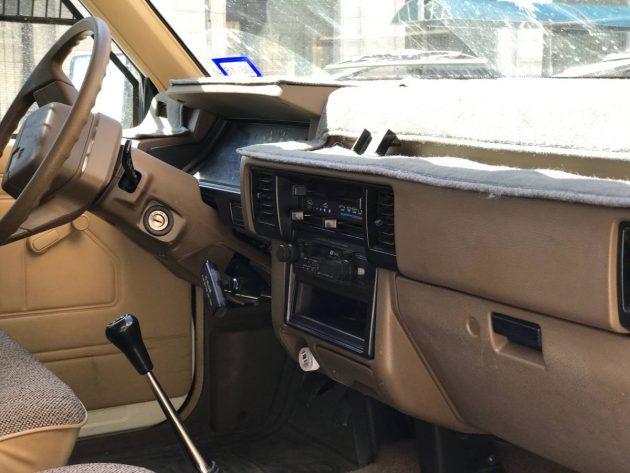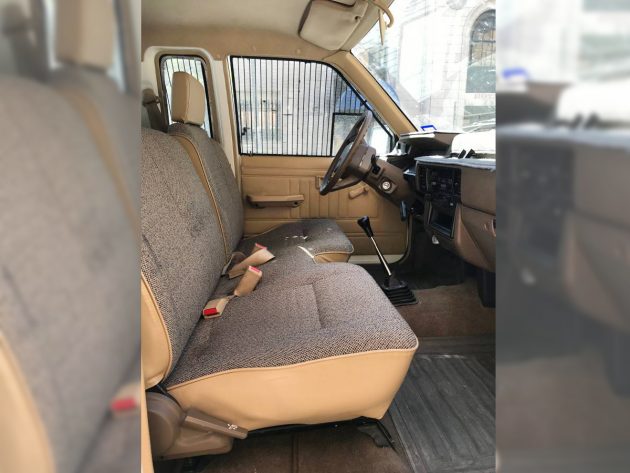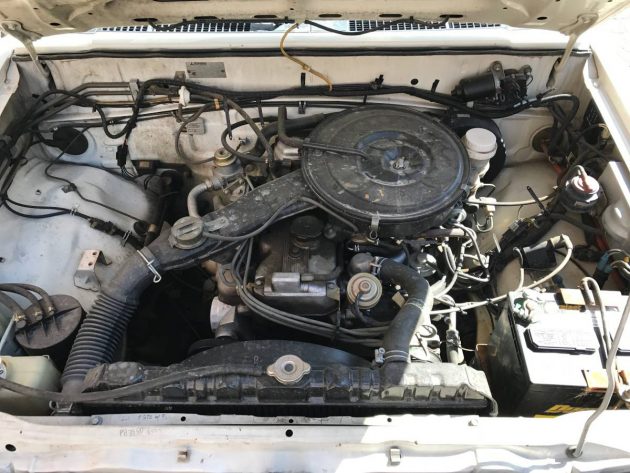Unless you’re pulling a horse trailer or a big camping trailer most of us could live with a smaller pickup, something the size of this 1989 Dodge Ram 50 extended cab. This one is on Craigslist or here on the CL archive and it’s located in beautiful El Paso, Texas. The seller is asking $2,800 for this one, right on what NADA lists as an average retail value.
Unfortunately, that first pic is the only exterior photo of this truck! I know, but let’s regroup and try to move on with our lives. At least what shows in that single exterior photo looks like an excellent truck, no? Yes. The interior looks fantastic from three photos and one showing the odometer showing almost 103,000 miles. This one even has what looks like screens on the window, that’s pretty unusual.
Yeah, this truck looks really nice to me. I have a 1980 Dodge D-50 Sport pickup and I wouldn’t mind another one, but what would I do with two small trucks? The extra space behind the seats would be great. The history of these rebadged Mitsubishi pickups in the US is confusing to say the least, starting as the Mitsubishi Forte then the Triton. Mitsubishi also imported their own version of the Forte to the US as the Mighty Max starting in 1982. This particular Ram 50 is a second-generation truck produced for a decade starting in 1986.
My 1980 Dodge D-50 Sport has the 2.6L inline-four with around 100 hp which has more than enough power for me, especially with a 5-speed. This truck has a 2.4L inline-four with around 116 hp. Well, ok it isn’t that much more horsepower. This truck really looks like a winner to me. Are there any other big fans of small pickups out there?






The Mitsubishi versions of this era are quite popular in NZ among the mini truck crowd. I’m guessing that the price is pretty reasonable for the Dodge version, stateside.
The 2.4 and 2.6 engines are pretty reliable and easy to work on, although not as tuneable as, say, a contemporary Nissan.
This one would make an excellent entry-level collectable, although I suspect it will never be valuable – who cares?
Can’t believe the asking price. I had a 92 mitsubishi in college with the EFI motor. These motors only go about 100k. I do remember it being quite zippy though, put a glass pack on it and let it dump under the bed. Sounded great!
It appears to be really nice.I’ve had a few Ford Rangers,and a few S10s.
I just really like a small pickup.It’s easier to maneuver in parking lots and in town driving.I’ve also had a couple tacomas,and currently own an ’02 Toyota Tundra.I like the 2000-2006 tundra body style.Most full size trucks are just too big for my liking.
I had one and will buy another one in a new york minute .. but .. the engines are usually only good for 120k unless they are very well maintained .. I ran slick 50 and full synthetic oil in mine and changed the belts at 50 and 100k and it still blew .. they had standard 6 lug bolt pattern and a stainless steel exhaust .. mine had a 600 watt stereo and was lowered and did 110 easily ..
Good idea. My biggest problem were its seats. They were uncomfortable! There was plenty of room to be comfortable, but the seats were unbearable when it was too hot in the summer, and too cold in the winter.
I had a ’73 Datsun 620 that I bought new, slammed it a couple of years later and made it go around corners (I think I’m still unofficially credited with being the first person to lower a mini-truck in SoCal).
Swapped the 1600 OHC for a warmed-up 2 litre and dropped an early (dog-leg First) SSS five-speed in it. The ‘ute’ came with me to NZ in 1981.
When I sold it, it had 250K miles on the chassis and still ran great.
Unlike its contemporary successors, it was simple, light and – even at stock height – one could easily put a motorsickel in the low bed. I really miss that little truck.
I’ve always liked the Datsun PL521 and PL620 trucks of the 70s. I love the relative simplicity compared to today’s trucks.
I remember when the compact truck was popular in the U.S.A. My stepfather had a 1978 Toyota Pickup truck. There was nothing fancy about it. It didn’t have air conditioning, no fuel injection, no power operated windows. I still loved driving the truck. It was simple, it was comfortable, it was utilitarian. I miss driving the truck.
We have CAFE standards to blame for the disappearance of compact pickups like this in the US. Basically, they can’t meet the fuel economy target for their footprint size, and the resulting guzzler tax would make them uncompetitive with larger and better-equipped trucks that can meet their target. Same goes for reasonably-priced station wagons, in favor of crossovers and CUVs/SUVs that get classified as trucks subject to laxer economy targets than cars.
http://www.thetruthaboutcars.com/2012/10/how-cafe-killed-compact-trucks-and-station-wagons/
That doesn’t make sense. Call me naive, but I would think that since the compact truck is smaller, and generally lighter weight, that would’ve made better fuel economy than a much larger and heavier truck. I would assume, for example, that a compact Dodge Ram 50 would’ve gotten better fuel economy than its big brother, the Dodge Ram D150.
Yes, but CAFE targets are scaled to the vehicle’s “footprint” size, so a smaller truck has to meet a higher MPG target than a larger one, and missing that target means it gets hit with a guzzler tax. Indeed, it doesn’t make sense, as this results in modest-sized, more fuel-efficient vehicles that can’t hit their target costing as much or more as a larger one that can, so they’re effectively priced out of the market.
@ SubGothius: How is that possible? I would think that the larger truck, because it’s larger and heavier than the compact truck would’ve been hit with a guzzler tax.